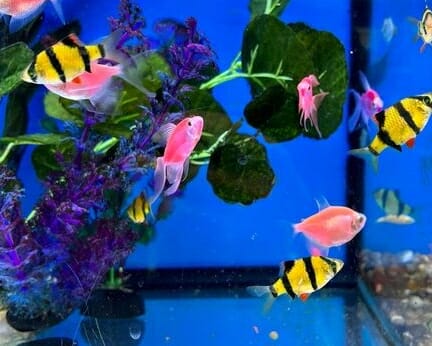Why Do My Tiger Barbs Keep Dying: Causes of Death and Preventive Tips

Here are four reasons tiger barb fish keep dying: over-feeding, poor water quality, lack of oxygen, and lack of space. Tiger barb fish are beautiful and lively fish that can add a splash of color to any aquarium. However, like all fish, they can die if not properly cared for.
If you notice any of these problems happening, be sure to take steps to rectify them. For example, change the water and add more oxygen if your water quality is poor. If your tiger barbs are over-fed, reduce the amount of food they’re getting.
And finally, make sure you provide your tiger barbs with enough space to live their happy lives.
Table of Contents
Top Causes of Tiger Barb Deaths
Overcrowding
If your tank doesn’t have the space for a tiger barb, you can consider purchasing one that is already raised. Unfortunately, these fish are usually harder to keep alive due to their smaller and more delicate nature. They need plenty of room to swim, hide, and clean water with a pH level between 6.0 and 8.0.
They need high-quality water with plenty of oxygen and should never be overfed. So make sure you take care of your new addition by paying close attention to its environment!
Overfeeding
Overfeeding can be a big problem for tiger barbs. They love food and will quickly gain weight if you give them too much. To ensure they don’t get over-fed, feed them once a day rather than twice.
If they still seem to be gaining weight slowly, try dividing their food into small meals instead of one giant serving. In addition, make sure they have places to hide and swim so they don’t feel stressed or crowded.
Rapid Changes
Tiger barbs are very sensitive to rapid changes in their environment. If you move them, change the water or add new fish, be sure to do it gradually, so they don’t feel stressed. Initially, please put them in a smaller tank with few additions and monitor their behavior closely.
As long as they’re healthy and adapting well to their new home, you can make more significant changes, such as moving them into a whole new tank. In addition, be sure to provide them with plenty of hiding places and clean water.
Disease or Parasite
Although unlikely, your tiger barbs may have contracted a disease or parasite. If you notice any odd behavior, like decreased appetite or lethargy, take them to a vet for an evaluation. Also, check their water for any signs of illness, such as green or black spots.
Loss of Beneficial Bacteria
Tiger barbs are a type of aquatic plant that can suffer from the loss of beneficial bacteria if their water is kept unclean. This occurs when chlorine levels increase, killing off the beneficial bacteria, which diminishes growth.
To prevent this problem, keep your tiger barbs’ water clean and free of chlorine if you notice any growth decline. In addition, add an excellent bacterial supplement to their diet.

Are Tiger Barbs Hard to Keep Alive?
Keeping tiger barbs alive can be a bit of a challenge. They need water and light to grow; if their conditions aren’t met, they will die. So make sure to water them well and provide them with the right light conditions to thrive.
If they don’t get enough water, you can try fertilizing them with fish food. If their growth is slow, it may be due to a deficiency in water or light. In that case, try giving them more of one or the other. However, this is not required every time. Keeping your tiger barbs well-watered and in the right light conditions will help them grow and thrive.
Tips and Tricks to Prevent Sudden Tiger Barb Deaths
Being sensitive, fish and tiger barbs need to be kept in an environment that is quiet and stable and provides them with plenty of hiding places and clean water. They should also gradually move into their new home so they don’t feel overwhelmed.
Make sure to feed them small food particles daily and monitor their health regularly. If something looks fishy, don’t hesitate to adjust to their water or tank conditions. Keep an eye on your growing tanks and adjust to keep your tigers healthy.
Tiger Barb Water
Make sure that the water your tiger barbs live in is clean and free of chlorine. This can be difficult, so enlist a fish expert’s help to ensure everything is attended to properly.
Tiger Barb Habitat
To keep your tiger barbs happy, they need a quiet environment with plenty of hiding places. Ideally, it would be best if you moved them into their new home gradually to avoid any stress. Additionally, please provide them with small food particles daily and monitor their water for signs of illness.
Tiger Barb Diet
It is essential to provide your tiger barbs with a healthy diet. They require small particles of food that they can digest, so make sure to give them a balanced and varied diet. For example, feed them flakes, pellets, or special tiger barb food cubes available online or at pet stores.
Tiger Barb Breeding
Tiger barbs are not commonly kept in captivity, so it isn’t easy to know how to breed them. It is possible to produce fry from two tiger barb parents, but this process is not easy and requires a lot of patience.
Tiger Barb Attitude
Tiger barbs are typically active and playful fish. They enjoy swimming and exploring their surroundings, so ensure they have plenty of room to play. Additionally, be gentle when handling them, as they can be delicate.
In addition, keep an eye on your tiger barbs’ water and tank conditions to ensure everything runs smoothly.
How Can I Revive Dead Tiger Barbs?
If you have lost a tiger barb in your aquarium, there are a few things that you can do to try and revive them. First, make sure that the water is clean and free of chlorine. If the tiger barbs live in a community tank with other fish, it is essential to test the water for signs of illness before adding them back.
Once the water is clean and healthy, add fresh food particles every day to help stimulate their appetite. If all else fails, consider contacting an expert who can help you raise another tiger barb colony or transfer your dead tigers into another tank.
